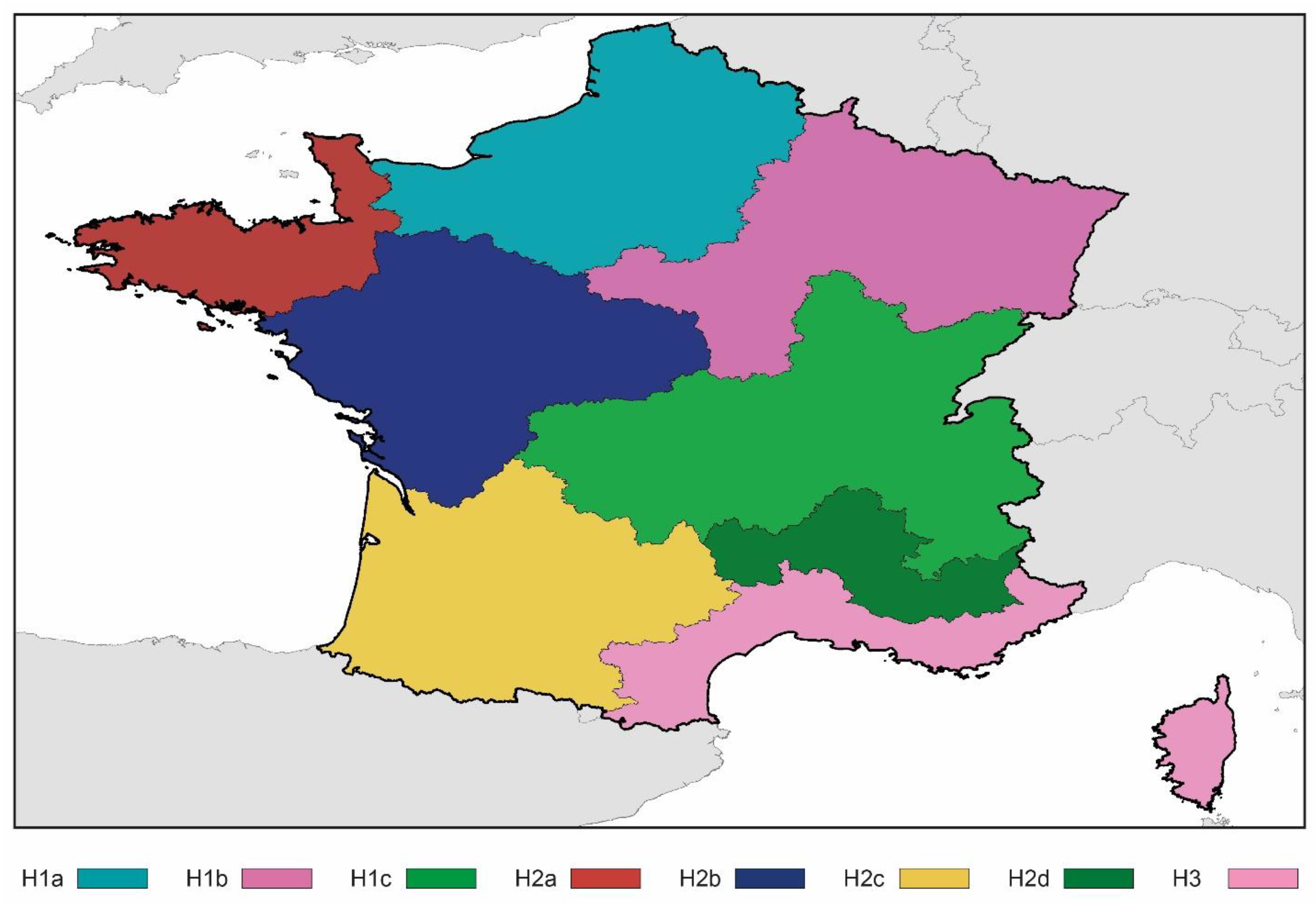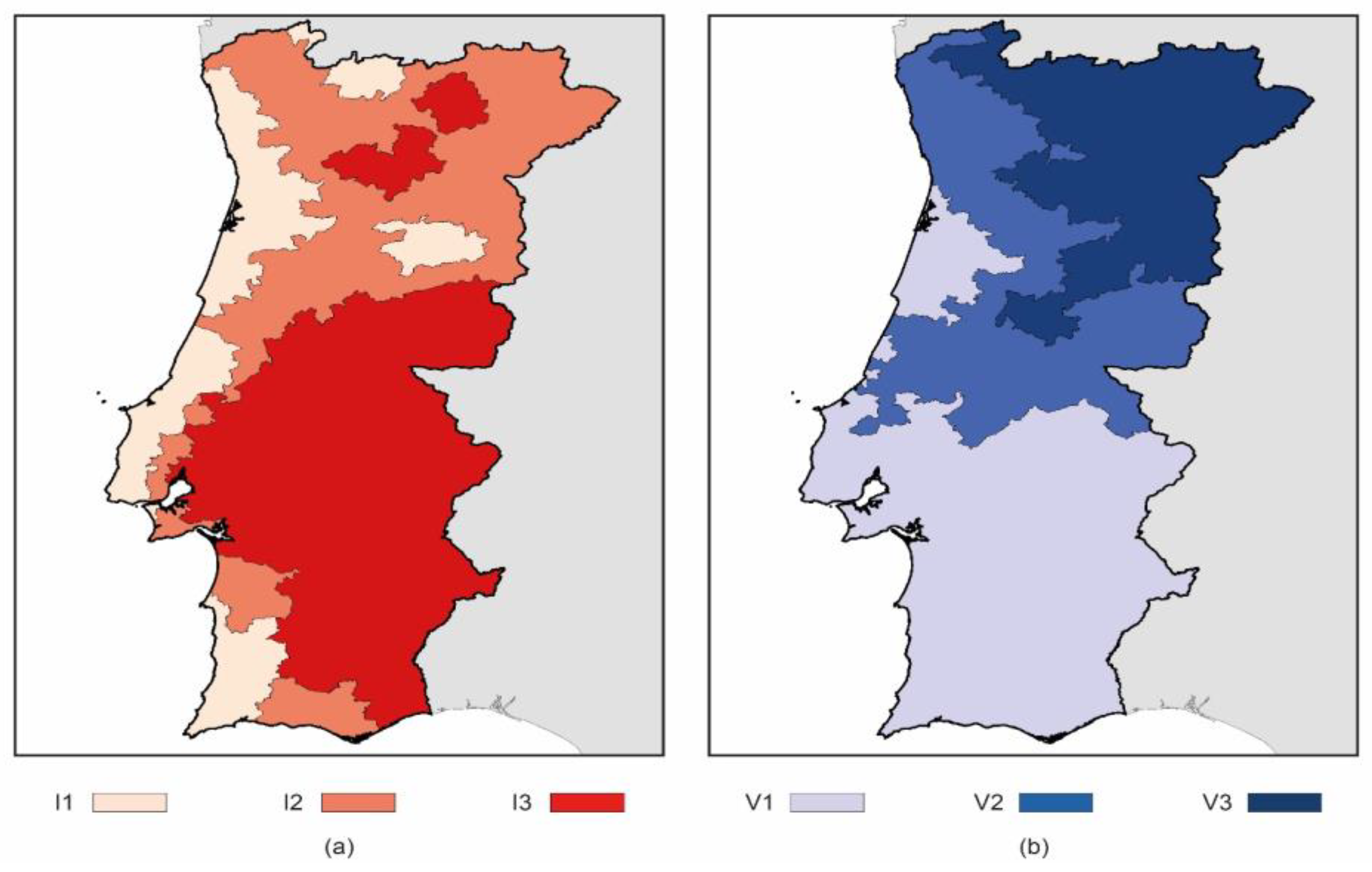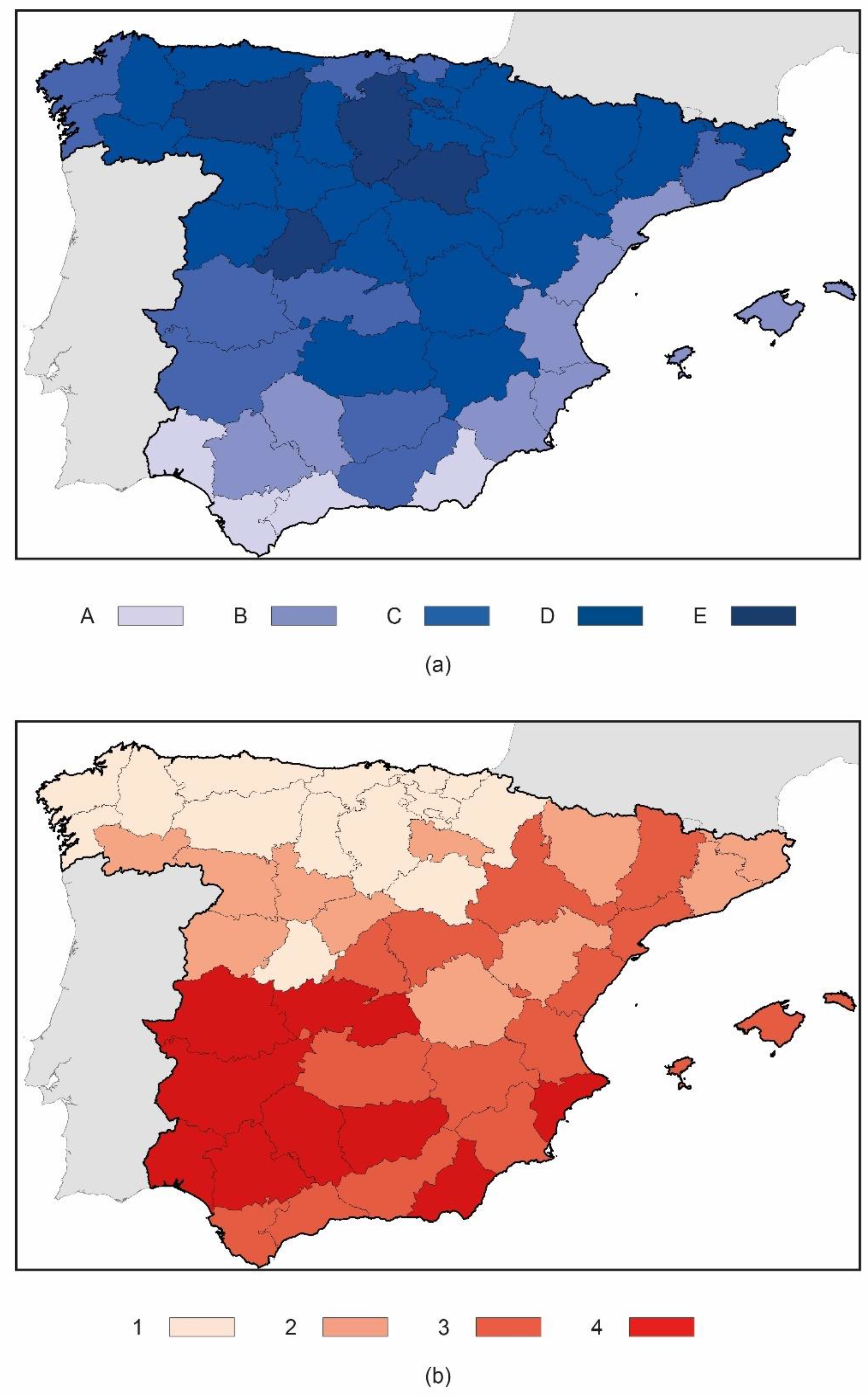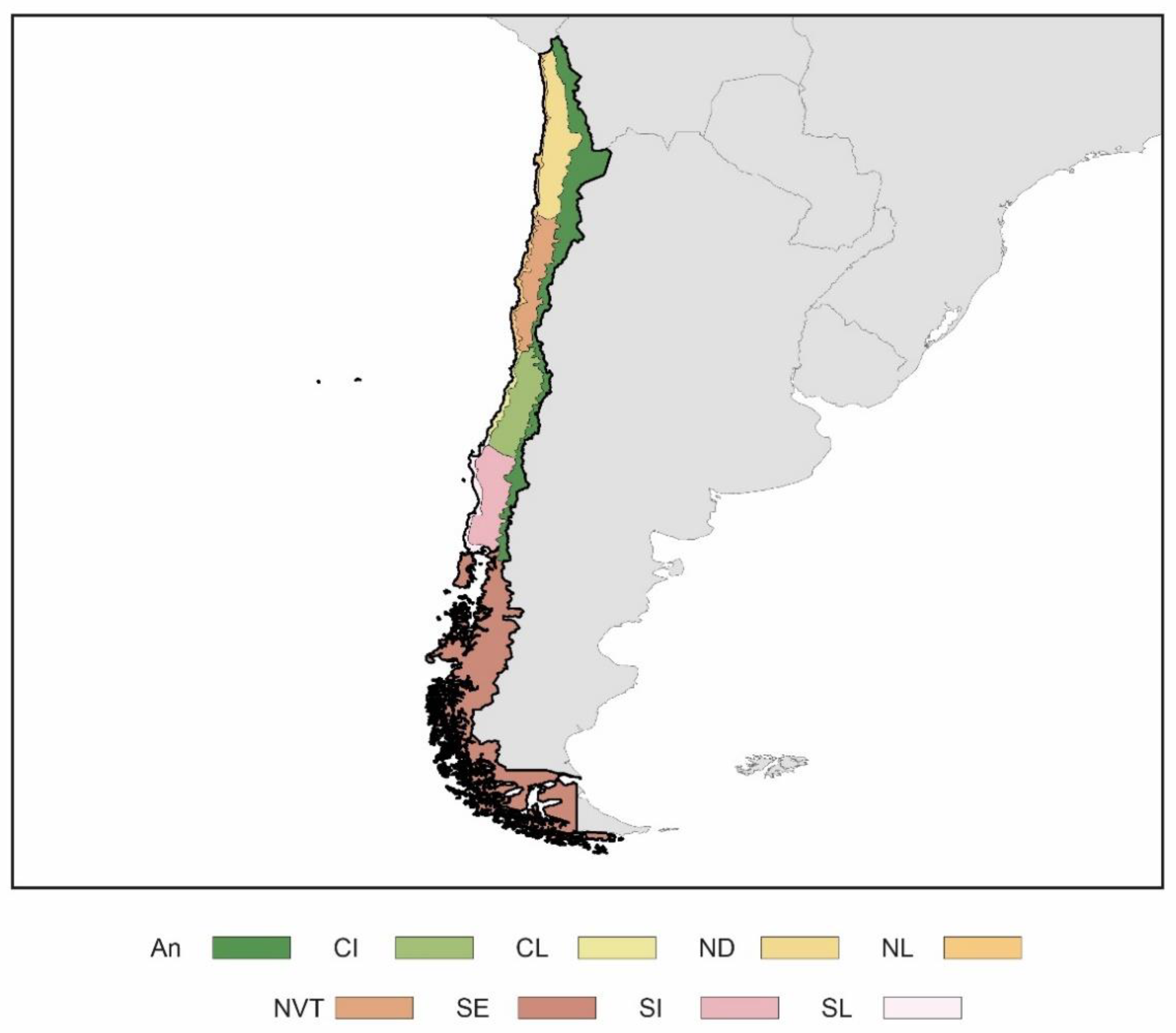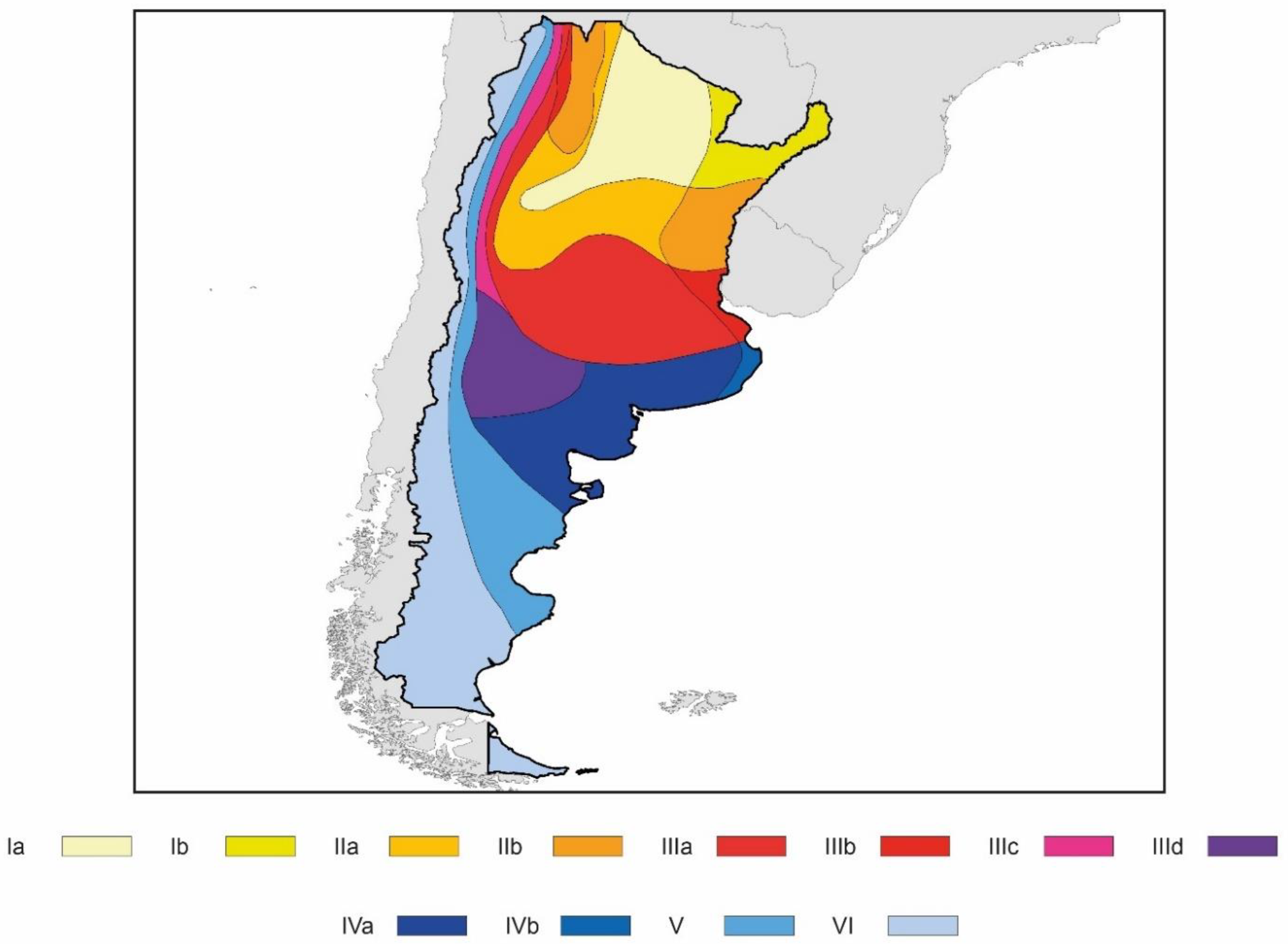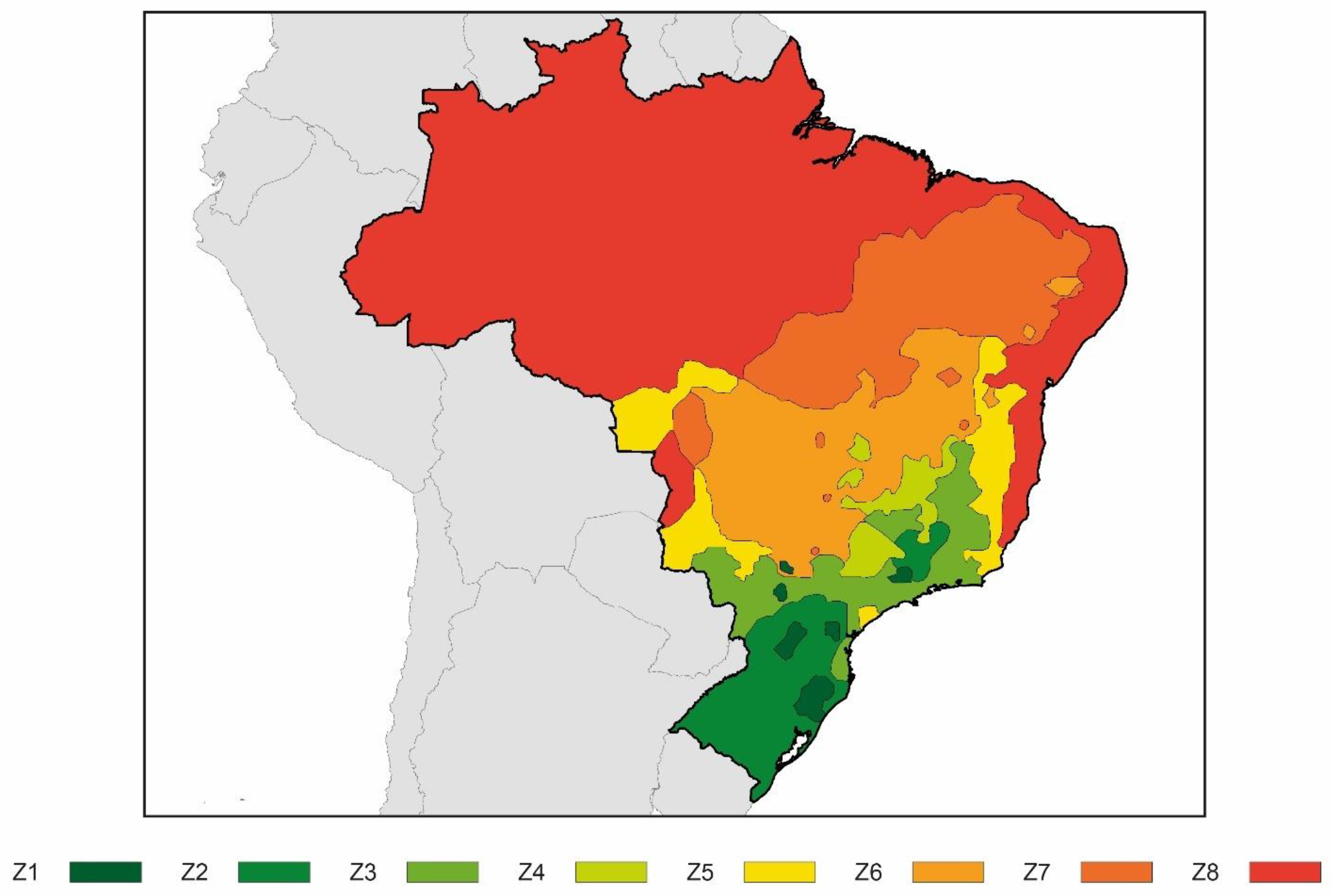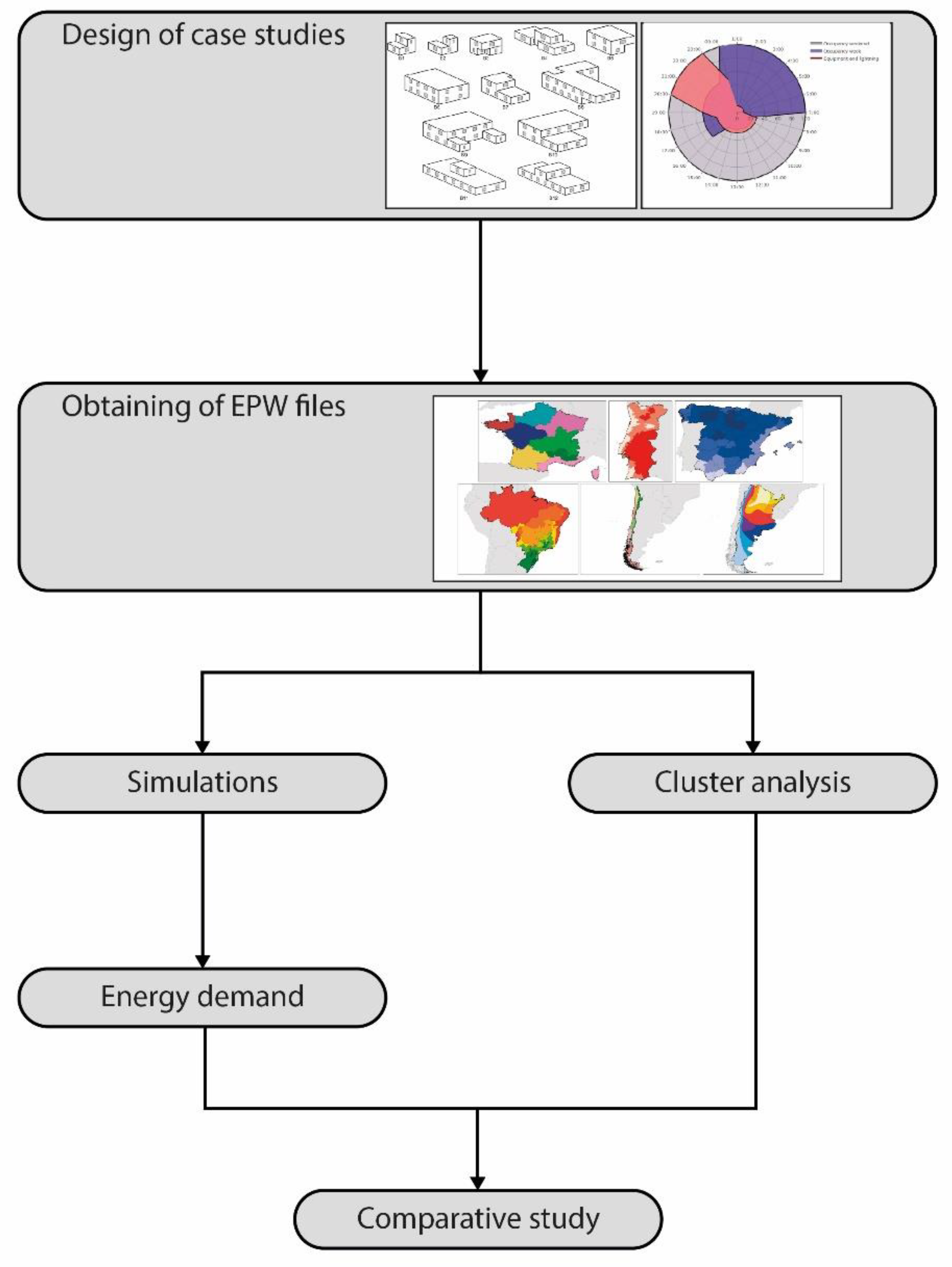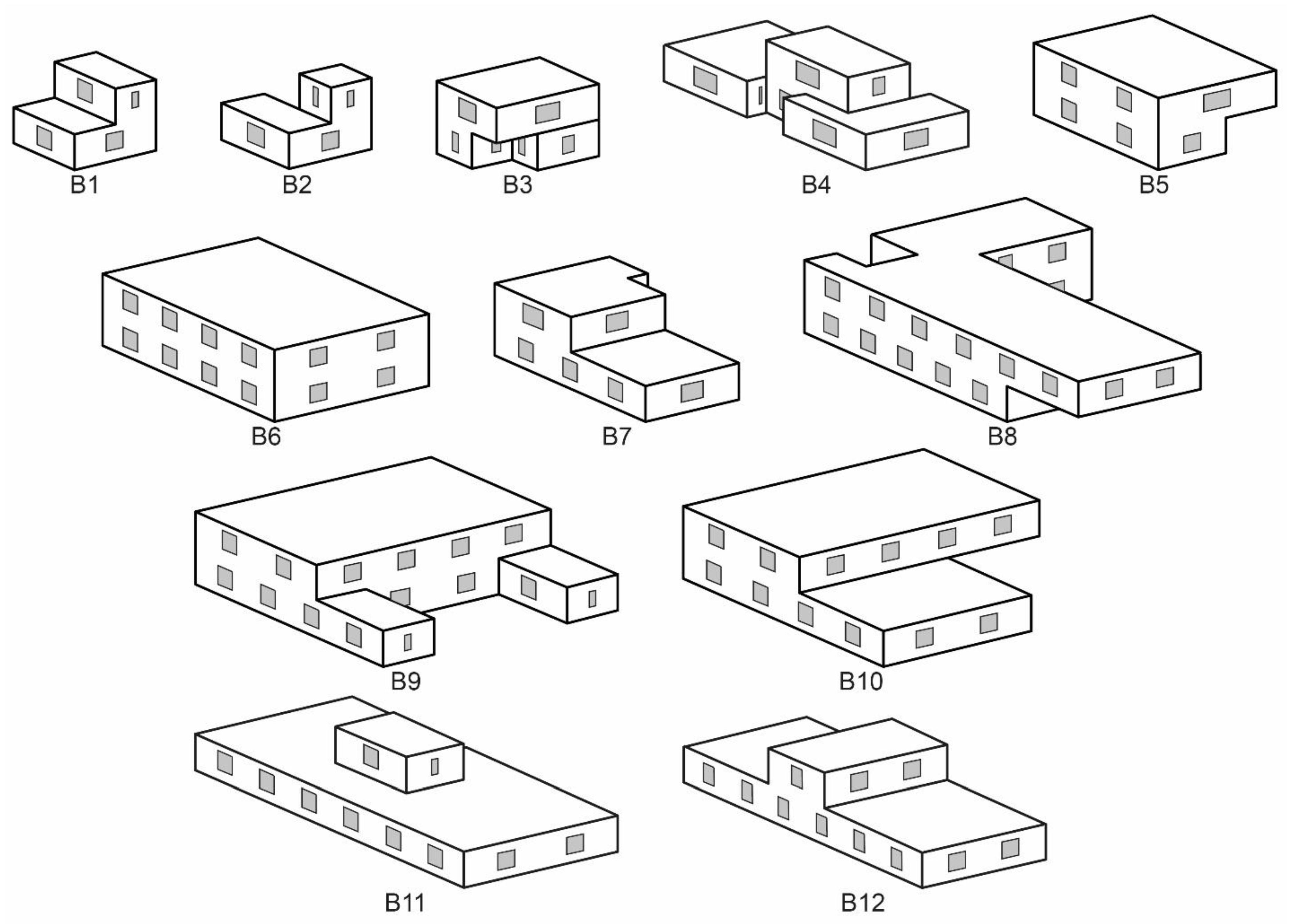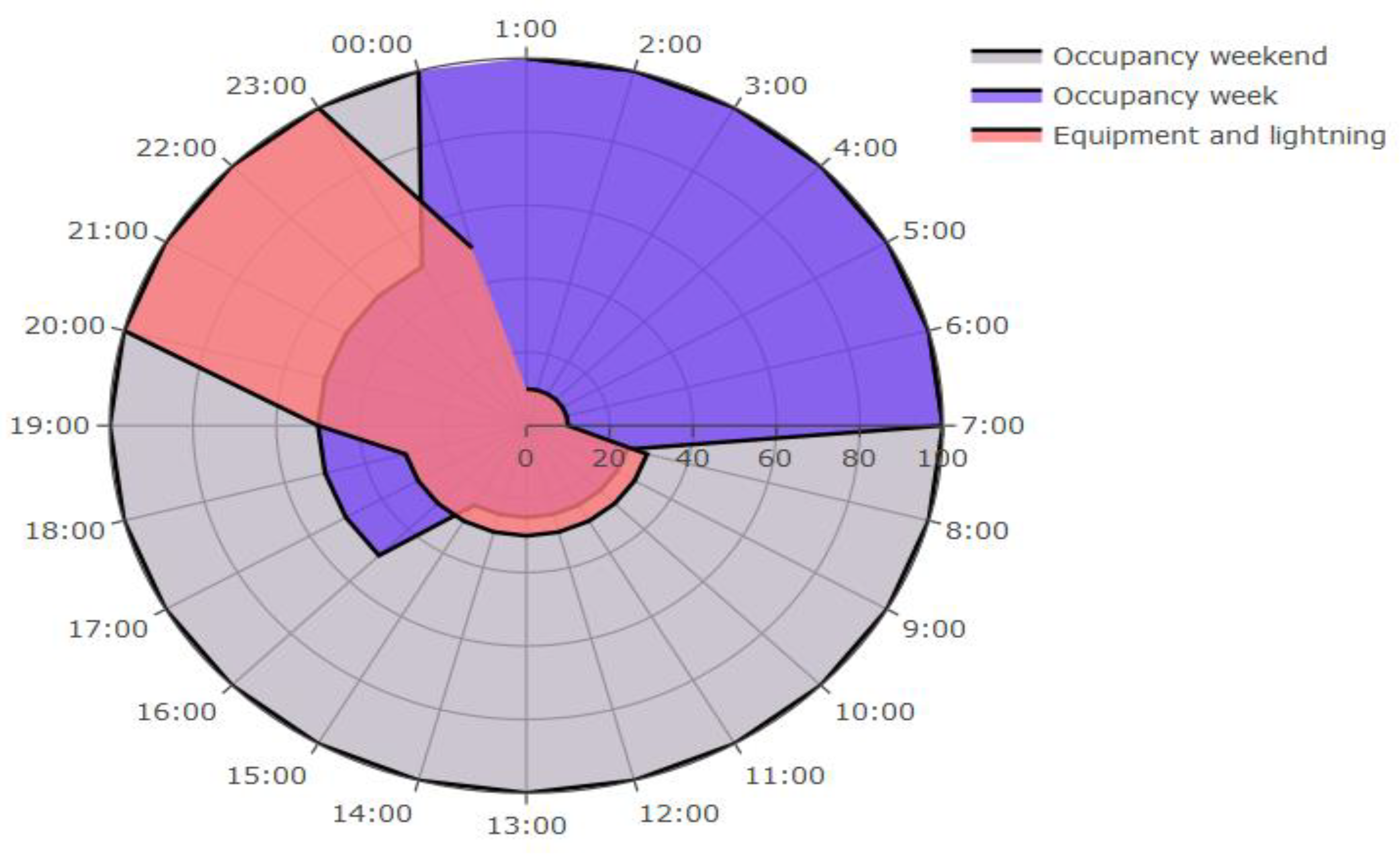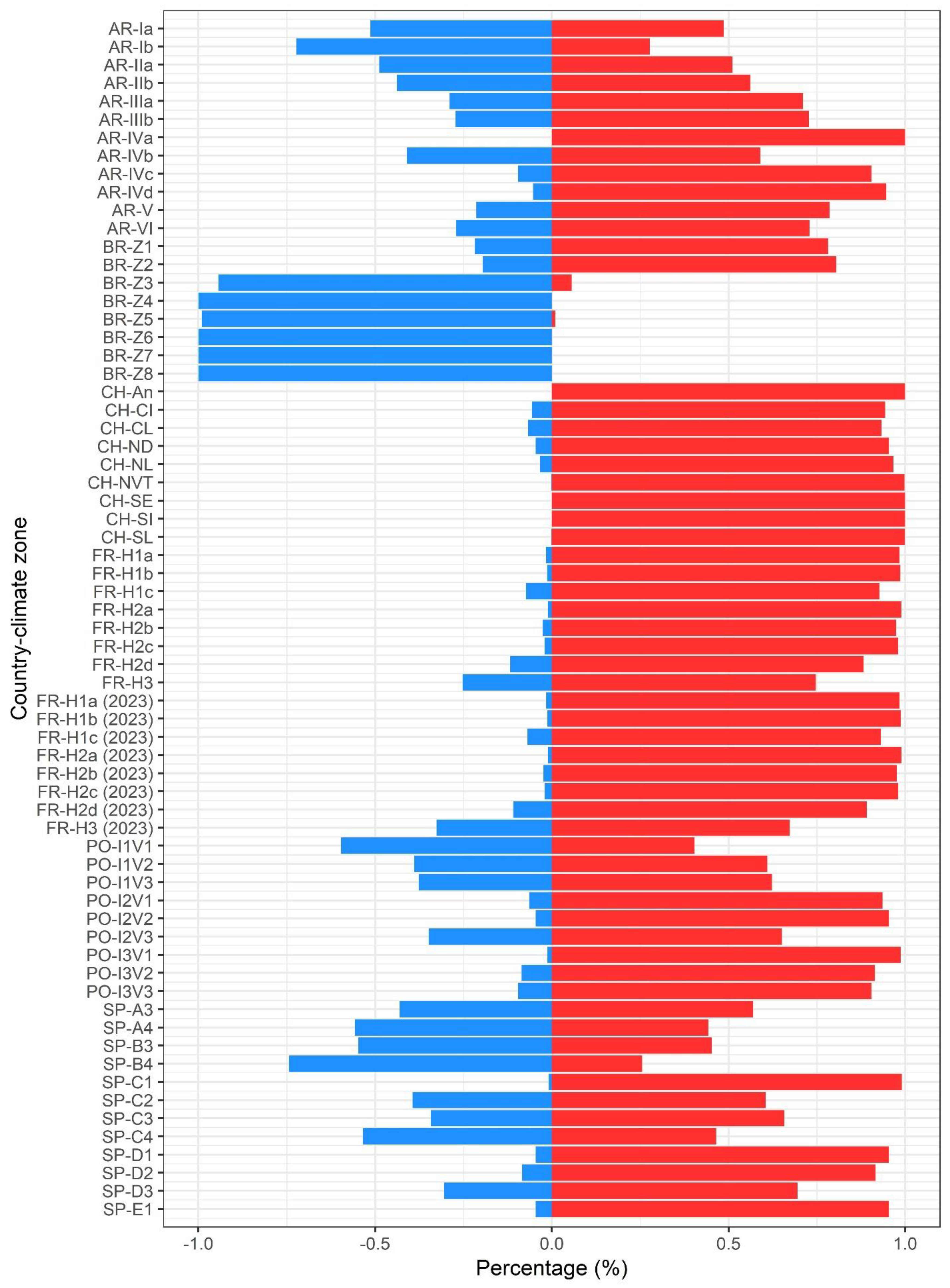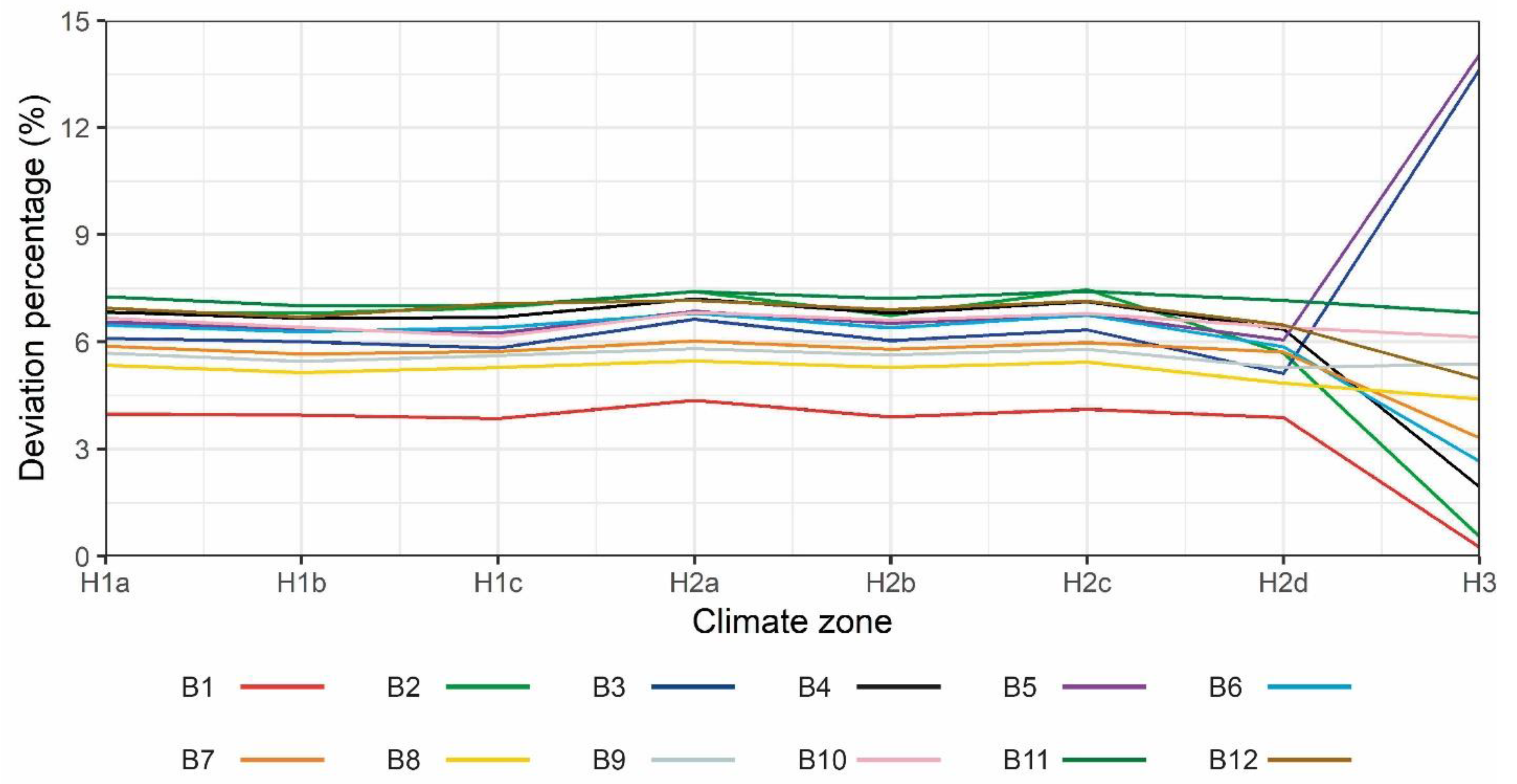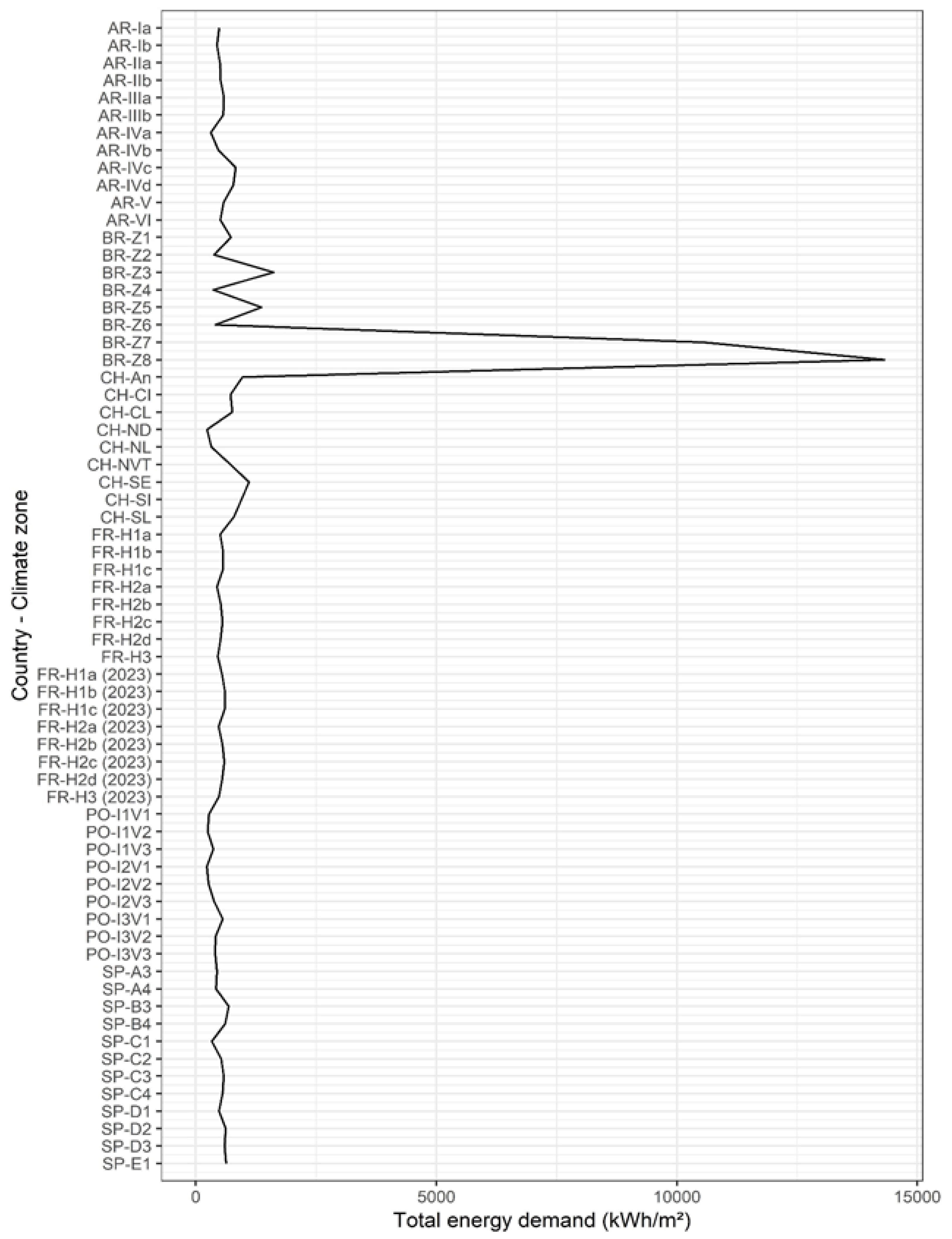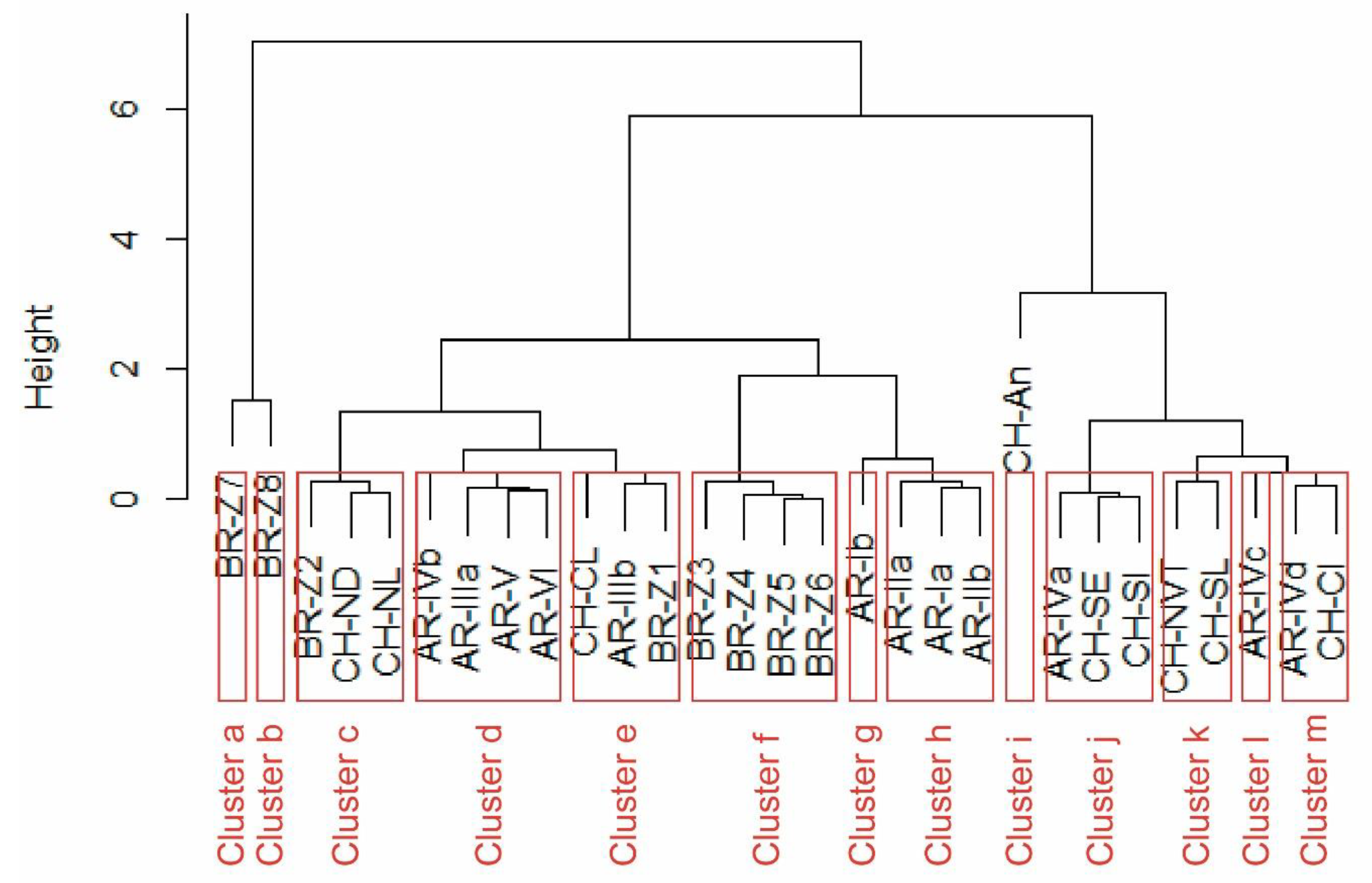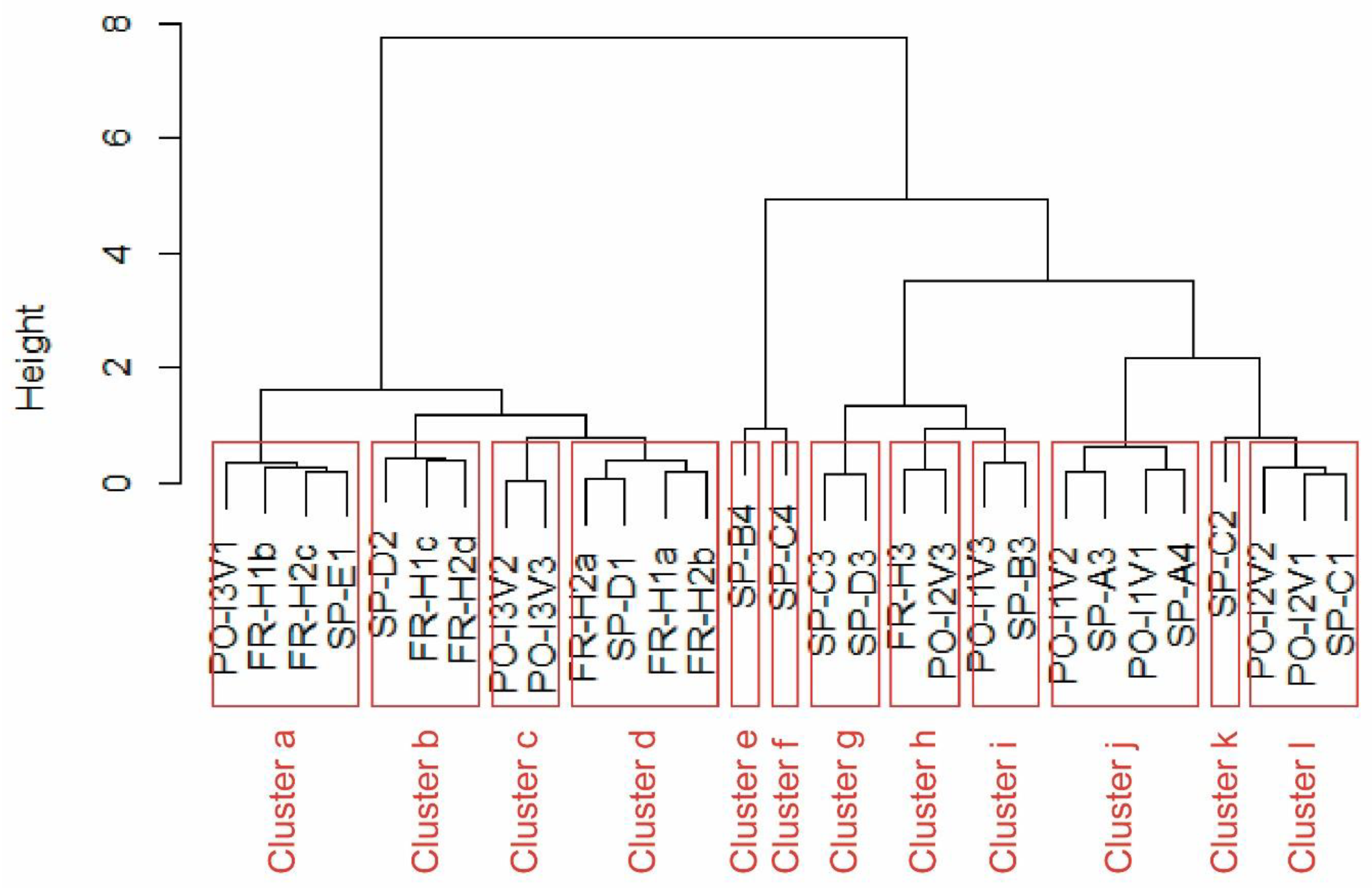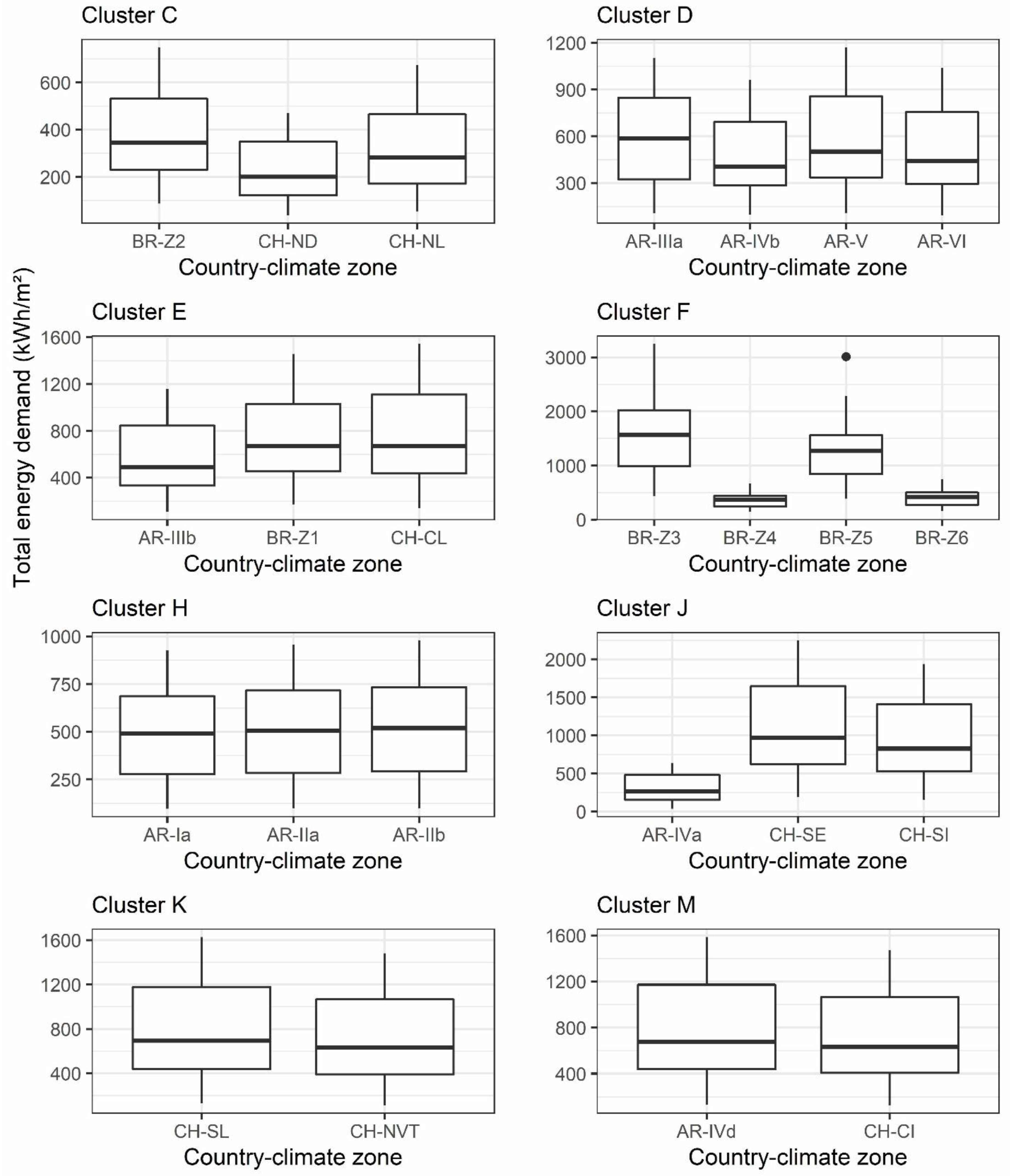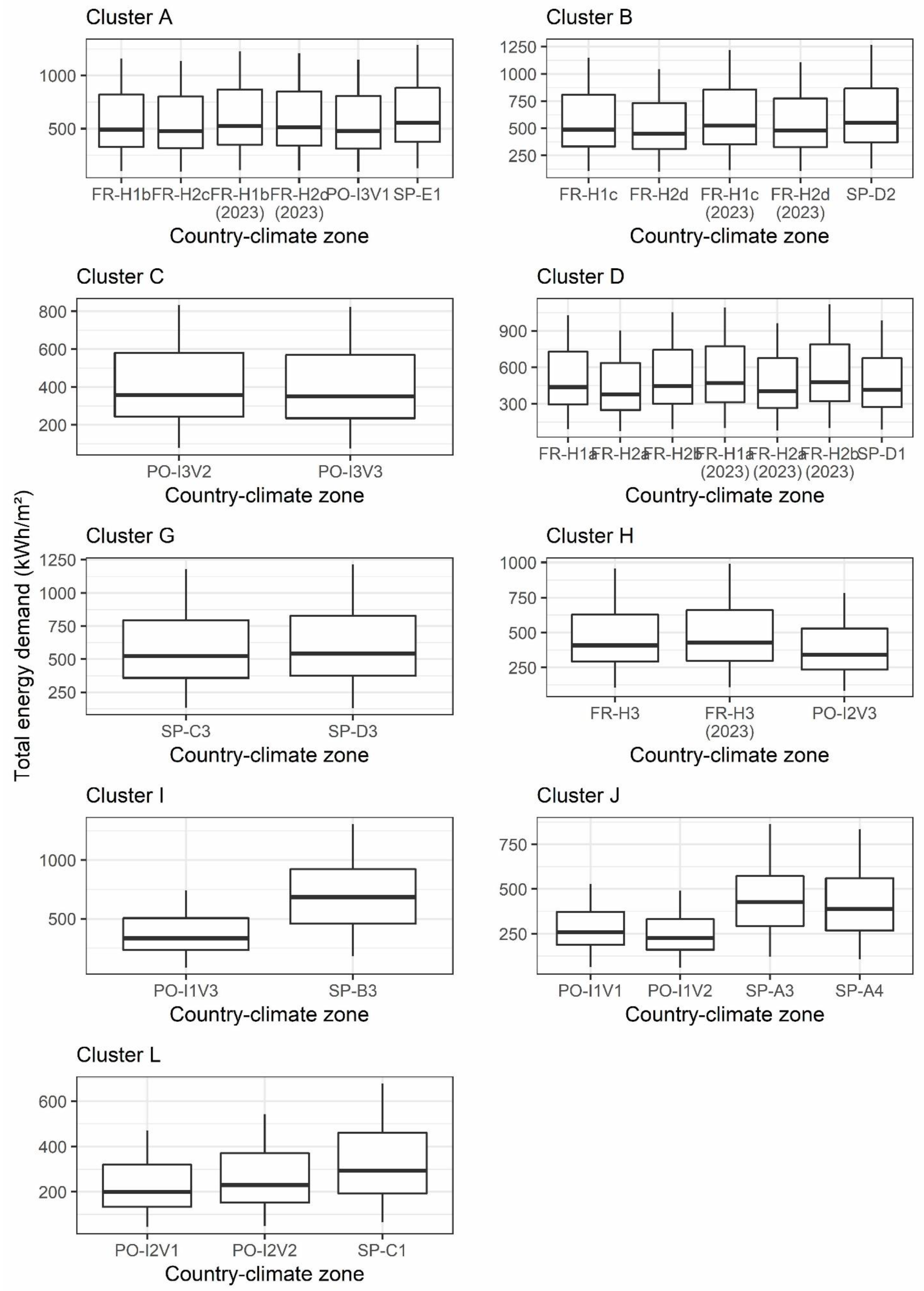1. Introduction
As a result of the oil crisis of the 1970s, concerns regarding the effects of climate change on the planet exponentially increased. High energy consumption, greenhouse gas emissions (GHG), and climate change nowadays constitute the main concerns of society. A greater requirement in the energy performance has been reflected in many sectors, including the building sector, as most existing buildings present bad energy behavior [
1,
2]. In quantified data, the building sector is responsible for 30% of the energy consumption worldwide [
3], generating 40% of GHG emissions [
4,
5] In addition, the use of fossil sources to produce energy aggravates this situation—most of the energy consumed in 2018 was produced by fossil sources [
6].
To reduce the progressive degradation generated by climate change, a total of 195 countries were committed to significantly reduce GHG emissions in the 2015 Paris Climate Conference, thus leading to ambitious objectives by 2050, both at continental [
7] and state [
8,
9,
10] scales. Most programs establish a demanding goal of reducing building energy consumption by more than 90% [
8,
9,
10].
To achieve such a goal, countries are designing regulations that establish limitations in the properties of buildings to guarantee their appropriate energy performance. Among the characteristics of buildings, setpoint temperatures [
11], compactness [
12], bioclimatic strategies [
13], efficient installations [
14], and thermal properties of envelopes [
15,
16] are those most influencing the energy performance, as the main type of consumption is the use of heating, ventilation and air conditioning (HVAC) systems [
17]. It is therefore essential for countries to ensure an acceptable energy performance of buildings through their regulations, and they should pay special attention to the limitation of residential building energy consumption [
18]. Even though there are several research studies analyzing the possibilities of modifying setpoint temperatures and compactness, thermal characteristics of building envelope are some of the main regulatory instruments, as establishing limitations in their properties is very easy, and they are directly related to the building energy demand due to heat losses and gains through them [
19,
20,
21,
22].
As for the European Union, most countries have widely developed since 1991 in relation to energy efficiency agreements [
23]. Regarding the energy efficiency of buildings, the European Union has the Directive 2010/31/UE [
5] as regulatory framework, which establishes the objective of guaranteeing the energy efficiency of European buildings. Through such a directive, each country of the European Union has developed different regulations on energy efficiency and adapted to them. The directive therefore does not establish specific technical objectives or demands for buildings. Among the highlights of the directive 2010/31/UE is the obligation that all new buildings from 31 December 2020 should be nearly zero energy buildings (nZEB). Consequently, European countries are reviewing their technical regulations [
24] with the added difficulty that, in the warmest regions, guaranteeing an acceptable performance in summer seasons is something of a challenge [
25].
Regarding South American countries, there are research studies proving that they are primarily the countries with high energy consumption, with a rising trend in recent years [
26] as the economy of these countries progressively increases [
27,
28]. Therefore, the adoption of proposals to reach categories of nZEB in their building stock would be promising, although reality shows that there is a lack of measures focused on this objective [
29,
30]. Nevertheless, South American countries are more and more aware of the energy saving, as reflected by their regulations [
31]. Many of them signed the 2015 Paris Climate Conference, and they are committed to reducing between 20 and 40% of the GHG emissions to the atmosphere [
32].
Most regulations from European and South American countries, however, establish requirements of thermal properties of building envelope according to the climate zone [
33]. These regulations present notable differences in climate classifications and technical requirements of thermal properties of building envelope to ensure an appropriate energy performance. This research, therefore, provides a general view of the existing advantages and limitations between the various state regulations and analyzes the possible differences between both continents. For this purpose, three South American countries and three European countries were analyzed. The South American countries selected were Argentina, Brazil, and Chile, and the reasons are as follows: they are those with the greatest surface of territory, they have a consolidated regulation on energy efficiency, and they have the greatest electricity consumption per capita in recent years [
34]. The Spanish countries selected were Spain, Portugal, and France, and the reasons are as follows: their geographic proximity allows similarity patterns to be established in their climate conditions, the difficulties of implementing nZEB policies in these regions [
24], and they have regulations on energy efficiency of the envelope with similar characteristics. A total of 792 simulations were carried out with EnergyPlus and were useful to adequately understand the performance the built building stock could provide according to the regulations of each country. Simulations were conducted in cities located in different climate regions of each country. Also, the properties of the envelope were adapted to the limit values established for each region. The analysis was based on the comparison of energy demand (i.e., the useful energy that HVAC systems would have to provide optimal thermal comfort conditions).
4. Results and Discussion
Firstly, the mean percentage contribution of each type of energy demand (heating and cooling) was analyzed in the different zones. This step was made before analyzing each climate zone in detail, as the aim was for the discussion to be based on the total energy demand to simplify its interpretation.
Figure 10 represents the percentage contributions of each type of energy demand. Results highlighted the heterogeneity of the climate zones and the thermophysical characteristics analyzed in the various countries. The greatest contribution of energy demand was due to heating in most climate zones—countries such as Chile and France as well as certain climate zones of Argentina (IIa, IIb, IIIa, IIIb, IVa, IVb, IVc, IVd, V, and VI), Brazil (Z1 and Z2), Spain (A3, C1, C2, C3, D1, D2, D3, and E1), and Portugal (I1V2, I1V3, I2V1, I2V2, I2V3, I3V1, I3V2, and I3V3) presented percentages greater than 75%. However, there were some zones where the contribution of the cooling energy demand was the most important type of energy demand (greater than 50%): (i) zones Ia and Ib in Argentina; (ii) zones between Z3 and Z8 in Brazil; (iii) zone I1V1 in Portugal; and (iv) zones A4, B3, and B4 in Spain. Among these zones, it is worth stressing the high contribution of cooling energy demand in zones of Brazil due to their location in latitude near the equator, which implies that the thermal oscillation between the different seasons is low and temperatures are warmer.
If these percentage values of cooling and heating are compared with the limit values regulated by the countries analyzed, three different tendencies are found: (i) Spain and Portugal establish fewer demanding requirements in the thermal transmittance of the building envelope elements located in zones with a greater cooling demand than in colder zones. As for Spain, the limit of thermal transmittance of walls goes from 1.25 and 1.0 W·m−2·K−1) in the climate zones of winter A and B, respectively, to 0.75 in the winter climate zone C; (ii) in Brazil, limit values of thermal transmittance are established between zones 3 and 6 and are similar to those of the coldest zones of the country (zones 1 and 2). Also, the regulation does not consider limit values for zones 7 and 8 (it is worth remembering that the case studies with the same limitations in zones 3 and 6 were analyzed in this study). This aspect reflects the little adaptation presented by these limit values according to the characteristics of each climate zone of Brazil with the same limitations in buildings located in warm and cold regions; and (iii) Argentina establishes a different criterion of regulation according to the severity in summer. As previously seen, the main limitation is established by the mean design temperature in winter, as lower thermal transmittance values are usually established. However, as for roofs, the characteristics of summer may demand lower values. In this regard, both zones with a greater cooling energy demand (Ia and Ib) correspond to zones in which the lowest thermal transmittance value of roofs in summer is established (it would be 0.18 W·m−2·K−1 for a level A), and this value increases in those zones with a lower cooling energy demand (e.g., zones IIIa and IVb), thus reflecting the climate adaptation presented by the limit values of Argentina.
After analyzing the percentage contribution of each case study in the various climate zones, the results of the total energy demand obtained by each case study were analyzed. It is worth remembering that the case studies presented different characteristics of orientation and design, which varied the total energy demand of each. The aim was to analyze the effect of the thermal limitations on statal regulations with different designs of buildings.
As for France, there were two limit values: (i) limit values for buildings designed and built before 1 January 2023 (see
Table 13); and (ii) limit values for buildings designed and built after 1 January 2023 (see
Table 14). This variation of limit values only took place in the opaque envelope elements. Regarding the results obtained, the zone and the configuration presenting the lowest total energy demand was zone H2a, with a percentage reduction between 7.08 and 23.41%. The next two zones with a lower total energy demand were zone H3 (with a percentage reduction between 7.09 and 16.91%) and zone H1a (with a deviation percentage between 1.89 and 10.50%), thus showing the favorable conditions of summer classification of type a of the French regulation, as they were those with the lowest energy demand. Regarding the zones with a greater total energy demand, zones with a summer classification of type c (H1c and H2c) were those obtaining the highest total energy demand values.
The same tendency was found with the limit values for 2023—zones of type a of summer had the lowest values, and those of type c had the highest. The new limit values, however, influenced the total energy demand (see
Figure 11). The percentage reduction was similar between the different zones, with average values between 5.34 and 6.50%. However, the values of percentage reduction presented a slight variation in zone H3. The values of percentage reduction were between 0.25 and 14.06%, whereas in the other zones, there was a greater concentration of such values of percentage reduction (between 7.47 and 3.88%). The reason could be the difference presented by the new limit values of the zone H3 in comparison with the other zones. As seen in
Section 2, limit values of thermal resistance in 2023 for zones H3 at an altitude lower than 800 m are 2.2 (m
2K)/W in walls. However, this limit value is the same as that used in current limit values, whereas in the other zones, there is an increase of 0.3 m
2·K·W
−1 in the limit values of thermal resistance of walls. This difference could lead to changes in the tendency of percentage reduction of zone H3 with the other zones. Anyway, the improvement of new limit values will improve the energy performance of buildings, although this improvement could be insufficient if compared with the results obtained in other regulations.
The results obtained in Portugal showed a better energy performance than that of France. In the climate zone where the lowest values were obtained (zone I2V1), the values of total energy demand oscillated between 44 and 469.1 kW·h·m
−2 (see
Table 15), whereas in the French zone H2a, they oscillated between 74.5 and 902.6 kW·h·m
−2. Comparing the results obtained in the different Portuguese climate zones, zone I2V1 presented average percentage reductions between 10.02 and 57.85% in the total energy demand with respect to the other zones. It is worth stressing that zone I2V2 also presented a lower total energy demand. If the limit value is more restrictive as the winter classification increases (i.e., a more restrictive value in zone I3 than in zone I1), these results highlight how some of these values adjust to the climate characteristics of each region. However, two aspects reflecting a certain limitation of the Portuguese regulation were found: (i) the values of total energy demand in the coldest regions (I3) were higher than those of the other winter climate zones, thus showing that the limit values for such zones need to be reviewed to guarantee that there is not a considerable energy difference between the buildings of the different zones; and (ii) in regions with the same winter climate classification, summer climate zones of type 3 presented a greater energy demand than zones 1 and 2 (e.g., zone I2V3 in comparison with zones I2V1 and I2V2), thus also reflecting the need to establish new limitations in the thermophysical properties according to the summer climate zone, which could be related to the thermophysical properties of windows (e.g., solar factor).
As for Spain, the results obtained were different and were characterized by a greater total energy demand despite the proximity and the possible similarity between the climate characteristics of Spain and Portugal. The lowest total energy demand was associated with zone C1, with a total energy demand oscillating between 66.9 and 677.6 kW·h·m
−2 (see
Table 16). The comparison with the other climate zones shows the huge difference with this climate zone, with a deviation percentage oscillating between 23 and 47.52%. The energy performance presented by the remaining zones was therefore higher than that of zone C1, thus showing a limitation of the limit values established by the CTE-DB-HE for the thermophysical properties of the envelope. The zones presenting a greater total energy demand were both cold (D2, D3, and E1) and warm (B3 and B4), and the latter associated the maximum values of energy demand in the 12 case studies (with values of total energy demand of up to 1306.4 kWh/m
2).
Regarding the South American countries, three different behaviors were found, as
Figure 10 shows: Brazil with a climate with a predominance of cooling energy demand, Argentina with a variable climate with a predominance of cooling or heating depending on the region, and Chile with a predominance of cold climates. In the case of the latter,
Section 2 includes that NCh 1079 was the regulation establishing limit values for all climate zones. Despite this detailed regulation, the results obtained of total energy demand showed that there are notable differences between zones. The climate zone that presented the lowest total energy demand was the zone ND, with a percentage reduction between 29.07 and 79.95% (see
Table 17). Thus, there was a huge deviation percentage between this zone and the others, as the remaining zones (except zone NL) had differences greater than 68%. The zone ND is characterized by establishing more restrictive values for the thermal transmittance of the envelope together with zones An and SE. Nevertheless, values of the NCh 1079 require review. Zones with more demanding limitations for the thermal transmittance should also be reviewed. The highest values of energy demand were obtained in zones An and SE, reaching maximum values of 1994.0 and 2246.5 kW·h·m
−2, respectively.
There was an improvement in the values of the total energy demand in the climate zones of Argentina. The values of total energy demand presented a maximum of 1680.4 kW·h·m
−2 (see
Table 18), thus meaning a reduction of 25.2% with respect to the maximum value of Chile recorded in the zone SE. Among the zones and the configurations with the best energy performance, the zone IVa was the most efficient. Limitations of IRAM 11605 and IRAM 11507-4 caused the percentage reduction of the case studies in this zone to oscillate between 36.39 and 65.0%. As the limit values established for the zone IVa were the same as those of the remaining zones III and IV (because the external temperature of design was the same), the best energy performance of the case studies was due to the climate of zone IVa. This aspect therefore shows that the detailed climate classification established by the standard IRAM 11603 does not present the same level of detail in the limit values of IRAM 11605, thus causing differences in the energy demand between the various zones. This would also be a reason why, in some cases, the energy demand obtained was lower in the coldest zones (V and VI) than in zones III and IV.
Finally, Brazil was the country associated with the greatest energy consumption. As
Figure 10 shows, most climate zones are characterized by a greater cooling energy demand. Also, those zones with a greater percentage contribution of heating (Z1 and Z2) corresponded to zones with a low total energy demand (see
Table 19). However, in zones with a greater contribution in the cooling energy demand, the values obtained were high. Values of total energy demand of 20183.4 and 34938.0 kW·h·m
−2 were obtained in Z7 and Z8, respectively, mainly due to the limit values established by the standard NBR 15575. This standard establishes similar limit values for the different climate zones, being characterized by the values of thermal transmittance of walls between 3.7 and 2.5 W·m
−2·K. Likewise, the Brazilian regulation does not establish limit values for the thermophysical properties of windows, thus leading to the high energy demand obtained in the case studies between zones Z3 and Z8. This aspect is in accordance with the low energy label, which is obtained by most social housing built in the country according to the NBR 15575 [
64].
The values of the total energy demand between the regulation and the climate zones of the countries presented different tendencies (see
Figure 12). The energy performance of the buildings built according to the Brazilian regulation is associated with a high energy impact in comparison with other countries. Consequently, new technical requirements need to be established in the thermal properties of the envelope with the objective of guaranteeing development and update of its efficient building stock with a low environmental impact. Regarding the other countries, Chile presents high values of total energy demand in some climate zones (e.g., SE and SI). There is also a notable difference in the tendencies of energy demand between the South American and the European countries analyzed; the latter were characterized by obtaining the lowest values of energy demand, whereas in the former, only some zones (e.g., ND in Chile and IVa in Argentina) obtained similar values. Despite the need to improve the European regulations, its wide development and update in recent years [
23] has led to higher adjustment of thermal parameters of the envelope in different climate regions compared to the South American countries. This is shown, for example, in the case of Spain, with four modifications in the energy regulation of buildings since 1979 (NBE-CT-79 (1979), CTE-DB-HE 2006 (2006), CTE-DB-HE 2013 (2013), and CTE-DB-HE 2019 (2019)).
Finally, cluster analysis was conducted.
Figure 13 shows the clustering of the climate zones of South America, and
Figure 14 shows the clustering of the climate zones of Europe. A total of 13 clusters were obtained in South America, of which five were not grouped with any other climate zone, whereas 12 clusters were obtained in Europe with only two individual clusters. From the groups obtained based on the heating and the cooling degree-days, the variations presented by the case studies simulated in the same groups were compared.
Figure 15 shows the box plots of the total energy demand of the zones studied in South America and
Figure 16 shows those of Europe.
As for the groups between different South American countries, there were differences in data distributions. In cluster J, the total energy demand in the zone IVa was lower than in zones CH-SE and CH-SI. Also, in some clusters grouping zones of the same country, such as cluster F, there were great differences in the results of total energy demand between zones. In Europe, there were similarities between the climate zones of Spain and Portugal, where the existing difference in the energy demand obtained in the case studies can be seen. The results showed that the Portuguese regulation generated a better energy performance than the Spanish regulation. These results reiterate the need for a general review of the thermal properties established in the regulations of the different countries and the use of new thermal variables, such as the periodic variables of UNE-EN ISO 13786 [
65]. In this regard, the Italian regulation establishes limit values for the periodic thermal transmittance of walls and roofs through the
Decreto Interministeriale 26 giugno 2015 [
66].
Also, the similarity relationships found through the cluster analysis between the regions of the countries suggest the possibility of establishing a community framework that regulates both the climate classification between different countries and the requirements for buildings. As a result, a new bioclimatic classification for all South American countries could be developed to establish reference values between different countries and to reduce the inequalities between the energy performance of the buildings built in different regions. In addition, this new regulatory framework should consider the possible limitations presented by each country (e.g., economic limitations) to allow a sustainable development of the building stock.
5. Conclusions
This study analyzed the regulatory framework of the properties of the building envelope in countries of South America and Europe. Particularly, regulations on energy efficiency of buildings of Argentina, Brazil, Chile, France, Portugal, and Spain were analyzed. Comparisons were conducted with 12 simulated case studies, which were configured with the thermal demands for envelopes established by each country for their climate zones.
Results showed different tendencies between the regulation and the climate zones of the various countries. One of the most important aspects is the high energy demand of buildings built according to the limit values established in the Brazilian regulation. In addition, tendencies of performance clearly different between the South American and the European countries were found, with the latter being those with the lowest energy demands. A detailed analysis conducted by the technical bodies of the South American countries to improve the energy performance of their buildings would reduce these differences. This aspect should be understood as a process of constant evolution similar to what happened in the European countries, which have updated their energy regulations over the years. Nevertheless, there were differences in the energy performance of the buildings located in different climate regions of the European countries, thus leading to the need to review the limit values established by the state regulations of the European countries to guarantee the removal of the existing energy differences between the buildings built in different regions of the same country. In this sense, one of the highlights in the regulations of the various countries is that establishing limitations according to summer climate conditions is not considered. This aspect becomes important in countries such as Spain, where the main energy contribution in some of its climate zones is due to cooling.
The cluster analysis conducted between the different climate zones was also useful to highlight similarity patterns between various regions of the same continent. The subsequent analysis of the distributions of energy demand revealed that buildings located in similar climates but in different countries present energy performances significantly different, thus leading to the same problem reflected between the energy differences in buildings of the same country. As occurs at a country scale, the development of regulations limiting the differences of energy performance between regions should be guaranteed at a continental scale. Climate analysis between countries to establish a valid climate classification for a whole continent, the proposal of new limit values, and even the use of other variables such as periodic thermal transmittance should be aspects to be reviewed by the leaders of countries.
To conclude, the contribution of this research to the energy saving of buildings is that limitations were found in the regulations of their envelopes. The efforts made by the governments of the countries analyzed to establish controls in the thermal parameters of the building envelopes to ensure an acceptable energy performance were highlighted. However, based on the results of this research, differences were found in the energy demand, thereby opening the discussion on the need for new criteria when establishing these policies at a state level. The development of more demanding policies related to the thermal properties of buildings and the analysis at a continental level could reduce the differences between countries and guarantee a more sustainable life for the building stock.
